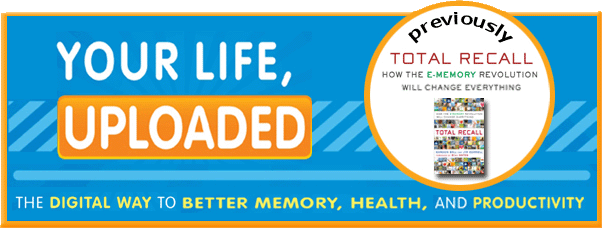Extreme Lifelogging (EL) of Everything Seen and Heard: Update, Speculation, and Ubiquitous Souveillance = Maximum Surveillance
 Thursday, April 11, 2013 at 8:57AM
Thursday, April 11, 2013 at 8:57AM With all the cameras aimed at continuous personal recording that Steve Mann called Sousveillance, it seems certain that “Extreme Lifelogging” by 2020 is certain—a prediction I made in 2010. Whether Extreme Lifelogging (EL), or for that matter, any technology becomes a useful product or service is based on three factors: Can it be done? Is it proven to be useful i.e. does anyone want it at that price? And is it legal? Until now, only a few of us were exploring whether it was useful for anything other than the creation of research papers including human interest stories about weird looking people. Only a few thousand cameras capable of near EL existed and were in use including a few being used for research to aid people with impaired memory. EL with images and AUDIO recording for everything we see and hear are yet to be available and in wide use by consumers, unless they are recording video. The recording of conversations, particularly phone conversations is certainly prevalent for commercial purposes, yet there is little real use of audio aka voice recording beyond video coming from glasses- or spy-cams. Audio recording is barely legal in some areas--but this will all change if and when the new generation marked by Google Glass (GG) come into use.
Generally overlooked is that a number of police forces are being equipped with high quality, personal video recorders attached to a patrol person or their car. http://www.nytimes.com/2013/04/07/business/wearable-video-cameras-for-police-officers.html?emc=eta1&_r=0Let me not discuss this because hundreds of articles, blogs, books, lawsuits, papers, and TV programs (including a real TV program of arrests) have been and will be devoted to this. Needless to say, because these devices are small, have to work and deliver reliable results, the engineering of this equipment is something that should be the envy of extreme lifelogggers. Watch, sunglasses, shirt button, etc. embedded video spy cameras are plentiful at less than $100 for surreptitious recording. Ironically, while sousveillance is also thought of as the inverse of surveillance, with pervasive and ubiquitous recording by everything by everybody, we will reach having the ultimate, full scale surveillance
Happily for those of us who believe there may be a utility of various facets of lifelogging this is all about to change brought about by cameras like the “Go Pro” still/video camera for sports. Smartphones e.g. iPhone host a plethora of time lapse photo and video apps that are only limited by imagination and battery life. Two SenseCam inspired devices from Autographer and Memoto are in the process of being engineered for introduction. All these devices will end up costing about $400 depending on whether there is some sort of service subscription for image storage. Sensr.net, a company I invested in, hosts video and time lapse photos from these sources as well has web cams.
Google Glass (GG) is the device that has drawn the most attention for several reasons: it is more than a video camera and mic mounted on the frame of a glasses; it has a speaker and display evolved from Thad Starner’s years of experience and displays; and finally it is a platform for apps. Already three Silicon Valley venture funds have formed the Glass Collective to support startup companies who will use GG as a component for apps. Thus, it is a safe bet that a significant app will emerge from so many tries.
A BET
I would like to place an optimistic bet that within 5 years, there will be 10 million GGs in use when priced at a few hundred dollars. In mid May 2013, one of the market research firm estimated 10M by 2015.
Alternatively, if someone has a more optimistic feeling and is willing to bet 2 years and just 2 million units, I’d take the conservative side—the side I usually win on.


